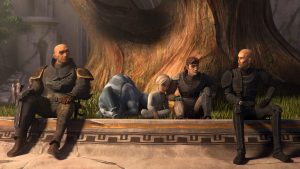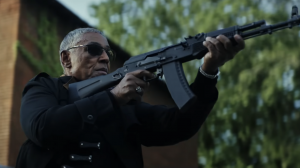
“It was all me, James. It’s always been me,” the villain played by Christoph Waltz reveals to super spy James Bond. “The author of all your pain.”
The name of that author? Ernst Stavro Blofeld. When Waltz revealed himself as Blofeld in 2015’s Spectre, he reversed a problem that had plagued the Bond franchise for decades: the long absence of 007’s greatest recurring arch-enemy and the huge stakes that came along with his every appearance.
How could the man who escaped every death trap and seduced every woman lose his man? How did the notoriously controlling EON Productions, which owns the rights to Ian Fleming’s novels, let one of its most important characters slip through its hands?
Turns out, the true author of Bond’s pain is the copyright office and the he said/she said litigation that slows down big budget productions.
The Birth of Blofeld
Ernst Stavro Blofeld first appeared in the 1961 novel Thunderball, the first of what Bond fans call the Blofeld Trilogy, along with On Her Majesty’s Secret Service (1963) and You Only Live Twice (1964). Blofeld plays just a small role in Thunderball, laying out that story’s evil plot for his organization SPECTRE (Special Executive for Counter-intelligence, Terrorism, Revenge, and Extortion).
Blofeld moves to the forefront in On Her Majesty’s Secret Service, in which the story turns personal. As Bond pursues Blofeld to put an end to SPECTRE’s activities, he falls in love with and marries Contessa Teresa di Vicenzo, better known as Tracy. But the marriage doesn’t last long, as Blofeld and his henchwoman Irma Bunt kill Tracy on her honeymoon. You Only Live Twice finds Bond on a warpath, hungry for revenge. Upon discovering his enemy under the alias of Swiss botanist Dr. Guntram Shatterhand, Bond tracks Blofeld and finally strangles him.
Fleming’s prose describes Blofeld as a large, imposing man with an almost spartan existence. His weighty presence was only increased by his strong moral code, one that compelled him, for example, to kill an associate who assaulted a kidnapping victim that SPECTRE promised to return unharmed after the ransom money was paid.
Although they did not follow the Fleming novels beat for beat, the James Bond movies did capture the tone of the character made for EON Productions. The character makes his first cinematic appearance in From Russia With Love (1963), where he’s referred to only as SPECTRE chief Number One. The camera never shows Blofeld’s face, and instead focuses on the white cat he holds in his hand, a conceit continued in Thunderball (1965).
After seeing his agents bested by Bond (Sean Connery) in previous missions, Blofeld decides to reveal himself in You Only Live Twice (1967), where he’s portrayed by Donald Pleasence. Blofeld escapes that encounter, only to reemerge as Comte Balthazar de Bleuchamp in On Her Majesty’s Secret Service (1969), where he’s played by Telly Savalas, a markedly bigger man than Pleasence.
As in the novel, On Her Majesty’s Secret Service ends with Blofeld killing Bond’s new wife Tracy. Thus, Diamonds Are Forever (1971) begins with Bond (once again played by Connery, with George Lazenby’s single-film-tenure concluded) on a mission of vengeance. Bond captures Blofeld and subjects him to death by drowning in cement, only to learn that he had been duped and the real Blofeld, portrayed by Charles Gray, is still on the lose and posing as billionaire Willard Whyte.
That movie ends with Bond getting his revenge by killing Blofeld in an explosion. And yet, 10 years later, For Your Eyes Only begins with Blofeld, his face hidden but apparently still in a wheelchair and neck brace from his last encounter with Bond, attempting an attack. Roger Moore’s Bond interrupts the attack to snag Blofeld’s wheelchair with a helicopter, lifting him into the air and dropping him into an industrial smoke stack. In his final moments, Blofeld pleads for his life, saying, “I’ll buy you a delicatessen – in stainless steel!”
And thus ends the story of Blofeld… at least until he reveals himself as the author of Bond’s pain 34 years later in SPECTRE.
Blofeld Escapes!
According to Pop Culture References, EON head Cubby Broccoli chose the line about a delicatessen as a reference to gangster double-speak, proving that, in the end, Blofeld was nothing more than a thug.
But the over-the-top and comedic nature of Blofeld’s drubbing also has a more mundane explanation. After being built up as the Moriarty to Bond’s Sherlock Holmes, Blofeld disappeared from the franchise after For Your Eyes Only because of a contract dispute between Fleming and producer Kevin McClory.
McClory had worked in the film industry for years when Fleming supposedly approached him in 1958 to adapt the James Bond novels, the first of which had been published in 1953 (Casino Royale). McClory passed on all of the Bond novels that Fleming had written up to that point, but he thought the concept had legs. Together with McClory, playwright Jack Whittingham, and his friend Ivor Bryce, Fleming wrote a screenplay called Longitude 78 West.
Aspects of that screenplay showed up in the 1961 novel Thunderball, but Fleming did not credit the others. McClory, Whittingham, and Bryce took Fleming to court, and all parties settled in 1963, receiving payment and credit on the book. From that arrangement, McClory entered into a deal with EON Productions to adapt Thunderball, which included a decade’s rights to the characters, beginning with the movie’s release in 1965.
The deal came to an end in 1975, but McClory announced plans to make his own adaptation of Thunderball anyway, separate from EON. Despite the series of suits that ensued, McClory’s project became 1983’s Never Say Never Again, starring 52-year-old Sean Connery as James Bond, Max Von Sydow as Blofeld, and Klaus Maria Brandauer as video game enthusiast and main villain Maximillian Largo.
Although Never Say Never Again bested EON’s official entry of 1983, the dismal Octopussy, McClory’s plans to make a new Bond series never came to fruition. After years of false starts, McClory sold the Thunderball rights to Sony in 1997. When Sony started making rumblings about producing a new adaptation of the novel called Warhead 2000 A.D., EON and its parent company MGM Studios took them to court, resulting in a settlement in which Sony surrendered its claims to the character.
McClory continued to insist upon his rights to Blofeld and SPECTRE and kept making production plans, up until his death in 2006. In 2013, McClory’s heirs officially sold their rights to EON, marking the end of the dispute and allowing Blofeld and SPECTRE to return to mainline Bond movies with Spectre.
The Return of Blofeld
Even the biggest Daniel Craig fans mark Spectre as a lesser entry in his Bond run, precisely because of Waltz’s take on Blofeld. Not only was Waltz uh…waltzing through a charming baddie role that he had done a million times before, but the screenplay — credited to John Logan, Neal Purvis, Robert Wade, and Jez Butterworth — saddles Blofeld with unnecessary backstory and a needless family connection to Bond.
More importantly, SPECTRE made for a strange fit in the more grounded world of the Craig movies. Not only did the Craig movies already have its own evil organization in the form of Quantum but the idea of a group of bad guys holding bad guy conferences steered too cheesy for the gritty world in which Craig’s Bond existed.
However, Craig’s tenure has come to an end and we’re on the verge of a new era of Bond. Many expect a return to the sillier, more comic-book nature of the hit Connery era, with Aaron Taylor-Johnson one of the names often rumored as the next lead of the franchise. Should EON turn toward the fantastic with their next Bond movie, then a Blofeld return makes perfect sense. After all, a decade-plus of MCU domination has taught the public to expect a big bad set up by overarching plots, many of which borrow from the Blofeld Trilogy in the first place.
In short, a new Bond calls for a new author of his pain, and nobody in the world of 007 writes pain like Ernst Stavro Blofeld.
The post How James Bond Lost His Greatest Enemy for 30 Years appeared first on Den of Geek.




